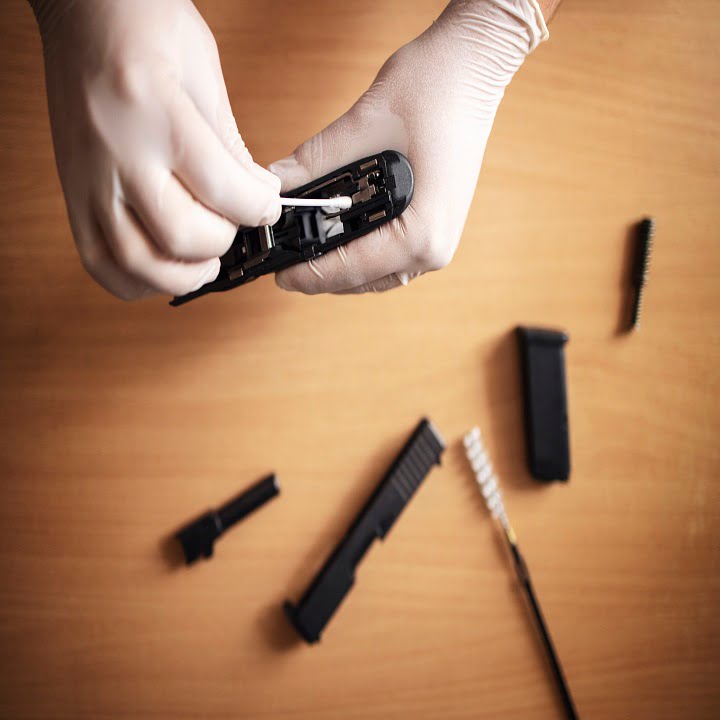
Firearm cleaning and maintenance after use at shooting range.
Table of Contents
Firearm maintenance is an essential part of responsible gun ownership. Proper cleaning and care can ensure that your firearm functions safely and efficiently, while also extending its lifespan. In this informative article, we’ll walk you through the steps to clean and maintain your firearm, ensuring it remains in optimal condition. With a friendly tone and easy-to-follow instructions, you’ll soon become an expert in firearm care. Let’s get started!
Regular firearm maintenance is crucial for several reasons. Firstly, cleaning helps remove fouling and residue that can accumulate over time, leading to reduced accuracy and potential malfunctions. Furthermore, proper care prevents corrosion and rust, which can damage the firearm’s components and weaken its structural integrity. Finally, regular inspection and maintenance allow you to identify any potential issues before they become more significant problems, ensuring your firearm remains safe and reliable.
To clean and maintain your firearm effectively, you’ll need a few essential supplies and tools. These include:
Some additional supplies can further enhance your firearm cleaning process. These may include:
Before you begin cleaning your firearm, ensure it is unloaded and pointed in a safe direction. Next, consult your firearm’s manual for disassembly instructions. Most firearms require at least partial disassembly for cleaning, which may include removing the bolt, slide, or barrel. Always follow the manufacturer’s guidelines to avoid damaging your firearm or voiding any warranties.
Once your firearm is disassembled, begin by cleaning the barrel. Apply some cleaning solvent to a bore brush or patch and run it through the barrel using a cleaning rod. Repeat this process several times to loosen and remove any fouling or debris. Next, use a dry patch to remove any remaining solvent and debris from the barrel. Finally, apply a thin layer of lubricant to a clean patch and run it through the barrel to protect it from corrosion.
Using a small brush or toothbrush and cleaning solvent, clean the action and other components of your firearm. Pay particular attention to areas where fouling or debris may accumulate, such as the bolt face, extractor, and chamber. Once the components are clean, use a dry cloth or patch to remove any remaining solvent. Apply a light coat of lubricant to the moving parts and any areas prone to friction or wear. Be sure not to over-lubricate, as this can attract dirt and debris, leading to malfunctions.
After cleaning and lubricating all components, carefully reassemble your firearm according to the manufacturer’s instructions. Once reassembled, perform a function check to ensure everything is working correctly. This may include cycling the action, dry-firing (if safe for your firearm), and checking the safety mechanisms. If you encounter any issues, disassemble your firearm and inspect the components for damage or improper assembly.
Finally, use a clean, lint-free cloth to wipe down the exterior of your firearm. This removes any fingerprints or oil, which can cause corrosion over time. You can also apply a thin layer of lubricant or a silicone cloth to the exterior metal surfaces for added protection against rust and moisture.
Proper storage is crucial in maintaining your firearm’s condition and ensuring its safety. Always store your firearm unloaded and in a secure location, such as a gun safe or lockbox. This prevents unauthorized access and protects your firearm from damage or theft. Additionally, store your ammunition separately from your firearm to further reduce the risk of accidents. Lastly, consider using a dehumidifier or moisture-absorbing packets in your storage area to prevent rust and corrosion.
In conclusion, properly cleaning and maintaining your firearm is essential for ensuring its longevity, performance, and safety. By following the steps outlined in this comprehensive guide, you can keep your firearm in optimal condition and enjoy a reliable, efficient shooting experience. Remember, responsible gun ownership includes regular maintenance and care – make it a priority, and you’ll reap the benefits for years to come.
Technology is revolutionizing the way we hunt and shoot. From GPS mapping and ballistics calculators…
Hunting during cold weather isn’t just about layering up your boots matter. When you’re sitting…
When you’re building or upgrading your AR-style rifle, one of the key decisions you’ll face…
When it comes to tactical rifle scopes, not all optics are created equal. The differences…
In today’s age of high-tech hunting, drones have transformed the way hunters scout terrain, locate…
Every hunter knows that a steady shot can make or break a hunt. Whether you’re…
This website uses cookies.